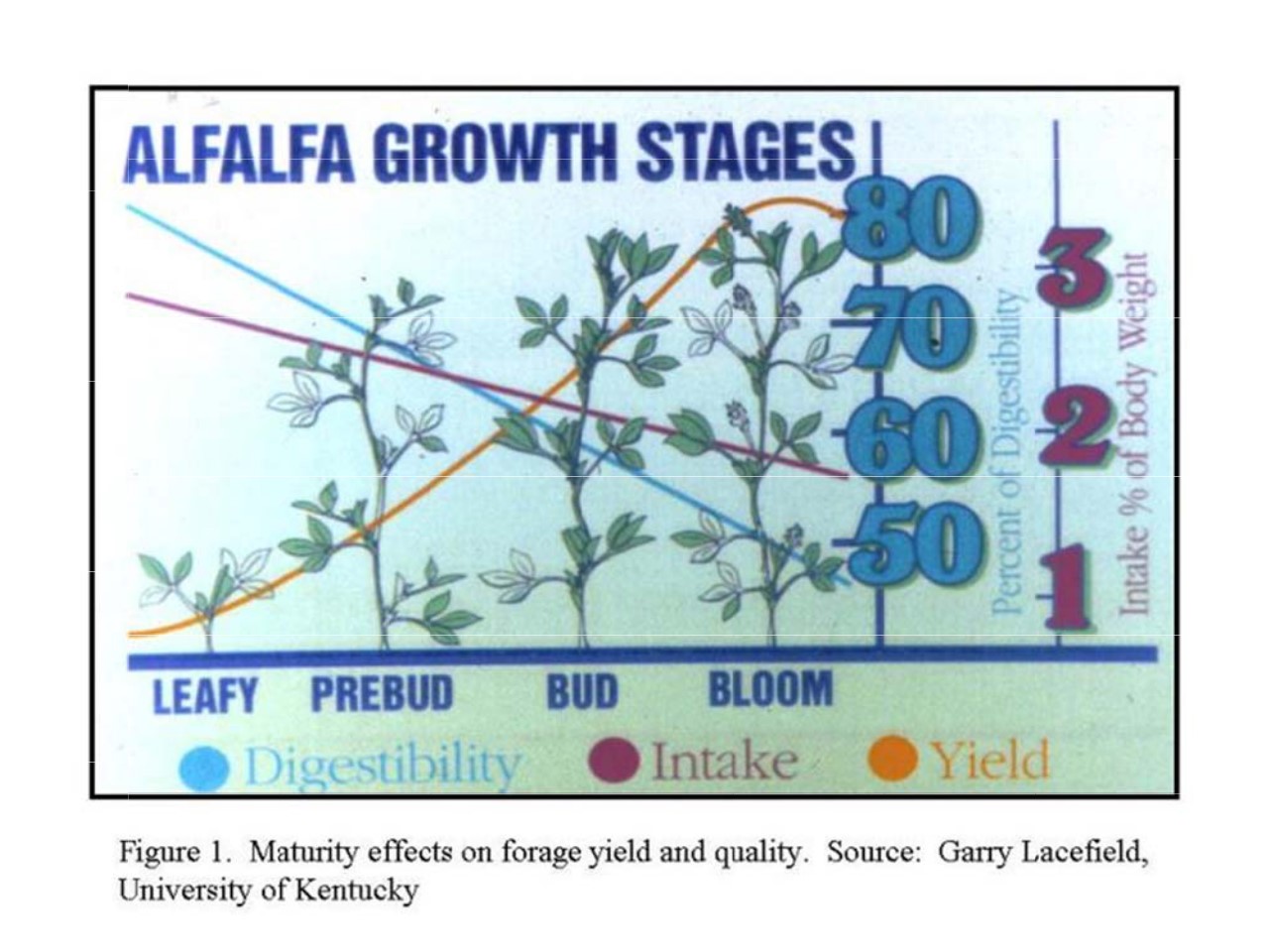Plant height must also be taken into consideration when determining the optimum harvest maturity. The effect of plant height on forage quality is illustrated in Table 1. This table is adapted from work done by Dr. Ken Albreck at the USDA-ARS Dairy Forage Research Center in developing the PEAQ (Prediction Equations for Alfalfa Quality) system. The RFV decreases with increasing plant height at all maturity stages (Table 1).
Table 1. Relative Feed Value (RFV) by Plant Height and Stem Maturity
| Height of tallest stem |
Late vegetative |
Late bud |
Late flower |
| 20 in. |
213 RFV |
191 RFV |
171 RFV |
| 25 in. |
191 RFV |
172 RFV |
155 RFV |
| 30 in. |
173 RFV |
156 RFV |
141 RFV |
| 35 in. |
156 RFV |
142 RFV |
129 RFV |
| 40 in. |
142 RFV |
130 RFV |
118 RFV |
Note that the RFV decrease 71 units at late vegetative, 61 units at late bud, and 53 units at late flower when alfalfa increases from 20 to 40 inches in height. Therefore, the taller the plant, the earlier in plant maturity that a harvest must be taken in order to get prime hay (RFV>151) in the bale. The PEAQ system estimates forage quality of alfalfa standing in the field so harvest must initiate at an estimated RFV of 175 or higher to allow for harvesting losses.
The height alfalfa plants obtain in each growth is dependent on the environment, especially precipitation and temperature. With adequate rainfall, an alfalfa plant will get taller under cool compared to warm environments before initiating flowering. Therefore, the first harvest generally is taller than a third harvest, especially on dryland. For example, the first harvest has averaged nearly 32 inches in height by the late bud growth stage at Fargo, ND, while a third harvest typically averages only 21 inches in height. Optimum plant maturity to initiate harvest therefore is markedly different during the first compared to the third harvest.
Typical plant maturity at harvest for the first cutting is late vegetative to very early bud in order to get prime hay in the bale. Typical plant maturity at harvest for the second, third, and fourth cuttings has been mid to late bud, 25-30% bloom, and 50% bloom or regrowth initiating. If rainfall is inadequate, the maturity a t harvest will be more advanced since the plant height is reduced by the lack of soil water. This spring was extremely early initiating plant growth and very warm. If the rest of the spring is cool like the next 10 days (last 5 days of April and beginning of May) appears to be, plant height could be greater than normal necessitating harvesting at late vegetative stag e for high quality hay.
Plant height has more effect on forage quality than plant maturity! Again, RFV decreases 61 units when alfalfa increases from 20 to 40 inches in height at the late vegetative stage (Table 1). But RFV decreases only 42 units from late vegetative to late flower at 20 inches in height and only 31 units at 30 inches in height.
In summary, adjust the maturity at harvest based on the height of the plant if you want prime hay in the bale. A quick way to evaluate height effects on forage quality is to use a R FQ stick, sold by Midwest Forage Association. Place the RFQ stick at several locations in the field and read the estimated RFQ of the standing forage.

